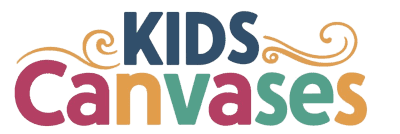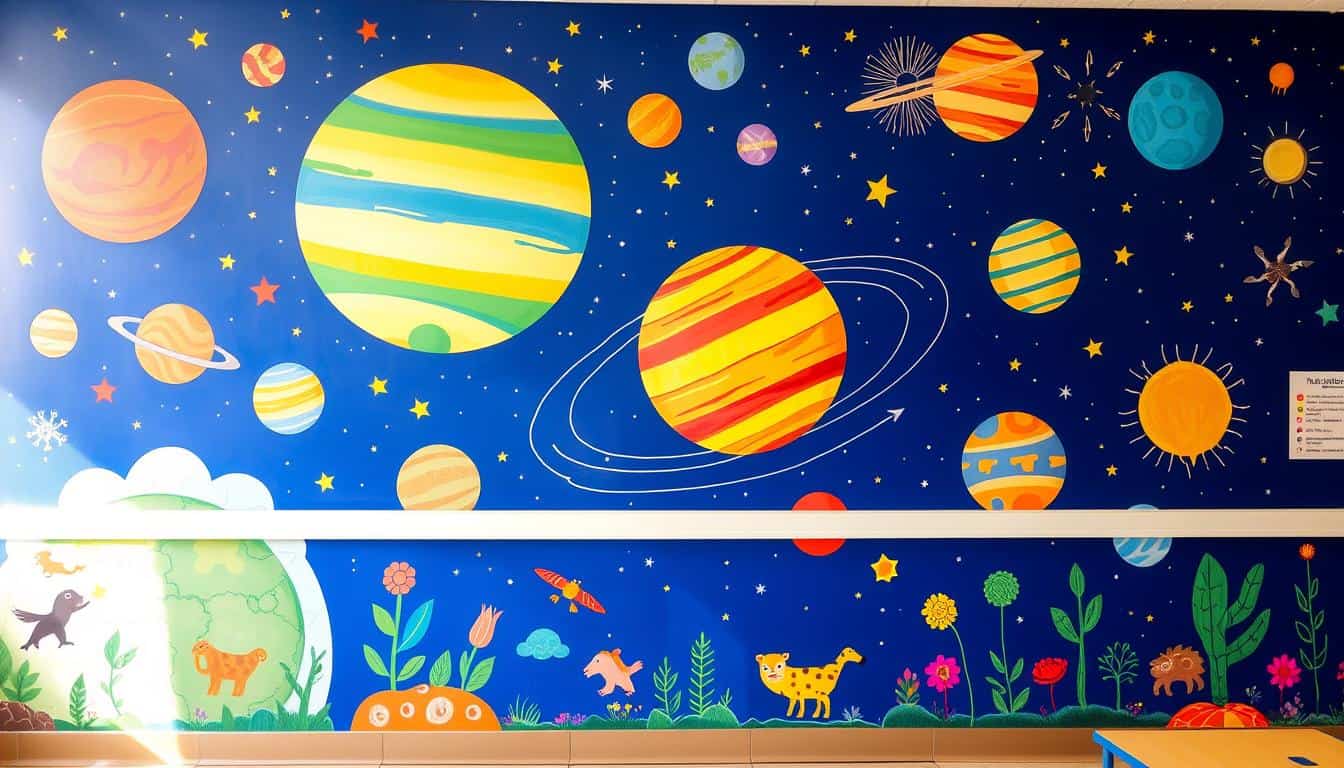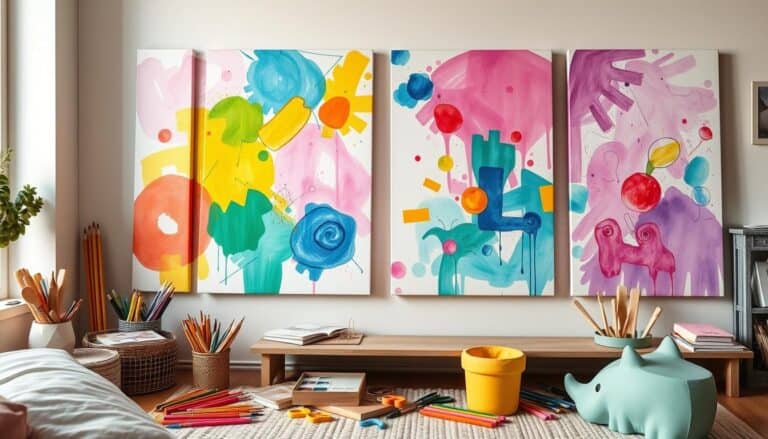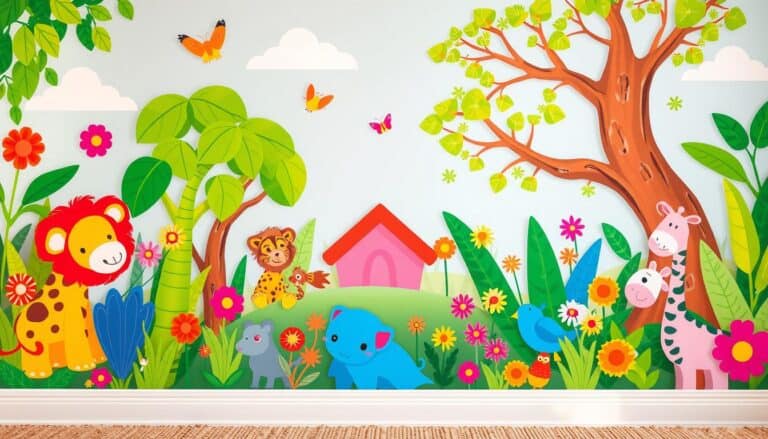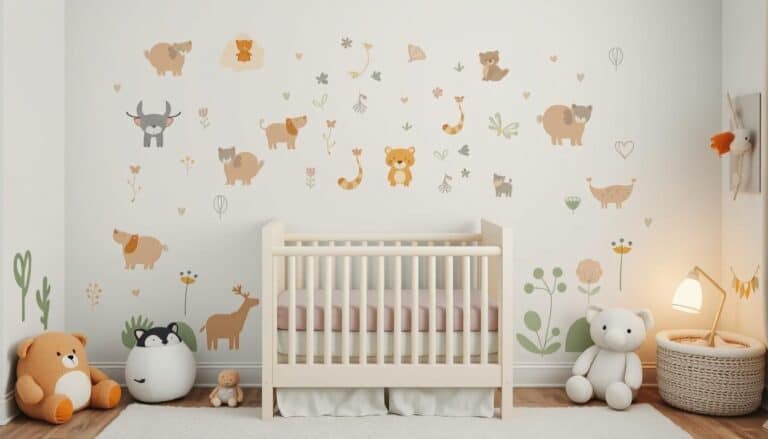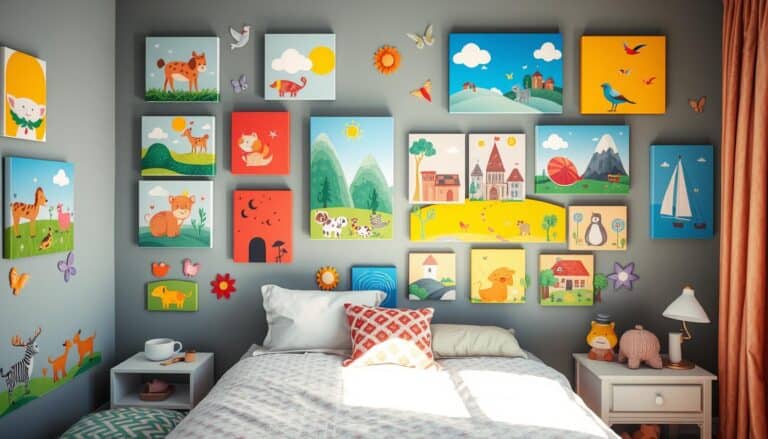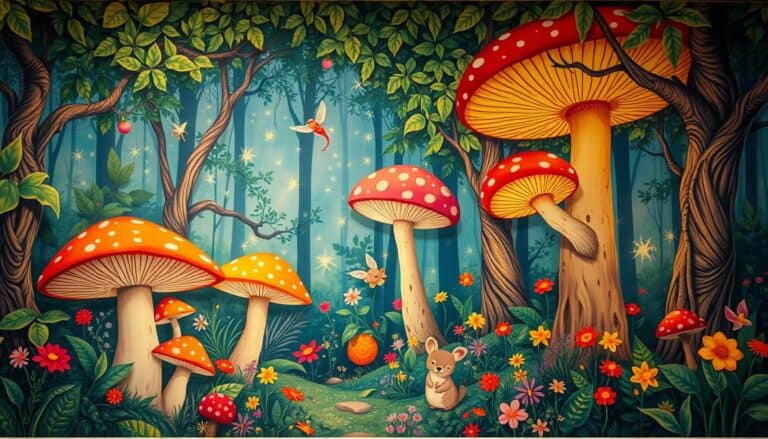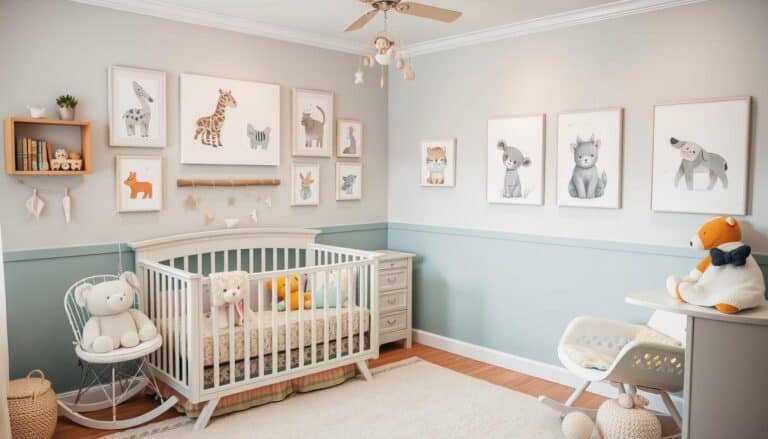Educational Wall Art for Growing Minds: Combining Decor and Learning
As a parent or teacher, you know how important a child’s learning space is. It shapes their curiosity, creativity, and love for learning. Educational wall art is key. It mixes Montessori decor with learning tools to make any room lively and educational.
Picture a room full of exciting visuals, quotes, and interactive parts. Educational wall art makes a room look good and reminds kids of the fun of learning. It surrounds them with things that match their interests and growth stages. This helps them want to explore and learn more.
The Growth Mindset Printable Boho Classroom Decor set is a great example. It has six JPEG files in different sizes, from 8.5×11 inches to 24×36 inches. It also has A4 and A3 sizes. With over 11 million followers, it’s clear many see the value in using affirmation cards and posters in learning spaces. It costs between $1.85 and $3.69, making it a budget-friendly choice for your child’s education.
Key Takeaways:
- Educational wall art combines Montessori-inspired decor with learning tools to create engaging environments.
- Carefully curated visuals and interactive elements nurture curiosity and creativity in children.
- The Growth Mindset Printable Boho Classroom Decor set offers high-quality, affordable resources for educators and parents.
- Affirmation cards and posters promote a positive learning environment and foster emotional regulation.
- Integrating educational wall art aligns with a child’s interests and developmental stages, supporting their cognitive growth.
The Importance of Educational Wall Art in Children’s Spaces
Educational wall art is key in making learning fun for kids. It turns their space into a place that sparks curiosity and helps them grow. This makes their room a special place for learning and fun.
Stimulating Curiosity and Creativity
Kids love to explore and learn. Educational wall art can make them even more curious. It can make them think creatively and imagine new things.
Wall art with themes like nature or science can make kids ask more questions. It helps them see the world in a new way.
Enhancing Learning Environments
Good educational wall art can really help kids learn better. It can make them focus and think clearer. But, too much can be too much.
Experts say to keep 20-50% of the walls free for learning. This helps kids stay focused and learn more.
Wall art with alphabets, numbers, and quotes can help kids learn to read and count. It makes them feel proud of their learning. Themes that show different cultures can also teach kids about respect and diversity.
Good wall art makes a room look nice and helps kids learn better. It makes them excited to learn and grow. This is good for their minds and hearts.
Types of Educational Wall Art for Kids
Creating a learning-friendly space for kids is key. Educational wall art is a big part of this. It includes inspirational quotes, interactive posters, and alphabet charts. Let’s look at some popular choices:
Inspirational Quotes and Affirmations
Motivational quotes and affirmations are powerful for kids. They help build a positive mindset and boost self-esteem. Wall art with messages like “Dream Big” or “You Can Do Anything” is great. These quotes remind kids to believe in themselves.
Interactive Learning Posters
Interactive posters make learning fun. They have colorful pictures and interactive parts. Kids can learn about the world and more while having fun.
Studies show posters help students remember things for a long time. They catch students’ attention and motivate them. Bright posters with fun pictures make learning exciting.
Alphabet and Number Charts
Alphabet and number charts are key for young learners. They help kids learn letters and numbers. Look for charts with bright colors and fun designs. Hang them where kids can see them often.
| Product | Original MSRP | Discounted Price |
|---|---|---|
| Alphabet Tree Activity Wall Panel | $2,177.90 | $2,072.76 |
| Bear Sensory Wall Decor | $102.12 | $95.22 |
| Bird Sensory Wall Decor | $54.76 | $51.06 |
Choose wall art that fits your child’s age and interests. Good posters are simple, attractive, and inspire learning. A mix of quotes, posters, and charts makes a great learning space.
Choosing the Right Themes for Different Ages
When picking educational wall art for kids, think about their age and what they like. Pictures and messages that grab their attention make learning fun. This makes their learning space more exciting.
Wall Art for Infants and Toddlers
Infant wall art should have simple, bright designs. These help their eyes grow strong and keep them curious. Use shapes, animals, and things they know to make them feel safe and happy.
Art Ideas for Preschoolers
Preschool art can be more detailed. It should match their growing interests and skills. Posters about letters, numbers, colors, and basic ideas are great. Add fun characters and scenes to spark their creativity and love for learning.
| Preschool Theme | Learning Objectives |
|---|---|
| Under the Sea | Marine life, colors, counting |
| Outer Space Adventure | Planets, constellations, science |
| Fairy Tale Forest | Storytelling, characters, imagination |
Motivational Pieces for Elementary Students
As kids get older, motivational art is key. Use quotes and images that push them to do their best. Themes like science, history, and books help them learn more and get curious.
“Believe in yourself and all that you are. Know that there is something inside you that is greater than any obstacle.” – Christian D. Larson
Choosing the right wall art for kids’ ages helps make their learning places exciting. It supports their growth at every step.
How Educational Wall Art Complements Home Decor
When setting up a home learning space, think about how educational wall art fits with your decor. Pick pieces that look good and are useful. This way, you make a space that’s both fun to learn in and cozy.
Using home learning decor wisely keeps your design looking good. It also adds something interesting for kids to look at.
Balancing Aesthetics and Functionality
Finding the right mix of looks and use is key. Choose wall art that matches your colors and style but also teaches something. For instance, a simple alphabet chart can teach letters and look great in a modern room.
- Custom kids’ art wall decor is a special mix of gifts, decor, and keepsakes.
- Parents, grandparents, teachers, and family friends usually buy this kind of art.
- Abstract paintings work well in modern homes and places that need creativity.
Incorporating Color Psychology
Color psychology is important for a good learning space. Colors can make us feel certain ways and affect how we think and feel. Think about these color effects when picking wall art:
| Color | Psychological Effect | Ideal Usage |
|---|---|---|
| Blue | Calming, promotes concentration | Study areas, reading nooks |
| Green | Refreshing, reduces eye strain | Science or nature-themed areas |
| Yellow | Stimulates mental activity, boosts creativity | Art corners, creative spaces |
| Red | Energizing, increases alertness | Active play areas, music rooms |
By choosing educational wall art that matches your decor and uses color psychology, you make a learning-friendly space. This way, your child’s learning journey is supported by a place that looks good and is fun to learn in.
Creating a Learning-Focused Atmosphere
Creating a good learning space is more than just putting up posters. It’s about thinking about how to keep students interested and motivated. A focused learning environment helps students do their best.
Classroom design can really affect how well students do. Things like lighting, air, and colors matter a lot. For example, bad lighting can make it hard for students to focus, especially those with special needs.
Tips for Arranging Artwork
Here are some tips for arranging educational art:
- Choose themes and colors that spark creativity and focus
- Change and update posters often to keep things interesting
- Use images that reflect students’ cultures to make them feel included
- Don’t overdo it with decorations to avoid distractions
- Think about students with vision problems and use colors wisely
Zones for Different Activities
Having different areas for different activities helps students stay on task. Here’s what you can include in your classroom:
| Zone | Elements | Benefits |
|---|---|---|
| Reading Corner | Comfortable seating, bookshelves, soft lighting | Encourages quiet reading and relaxation |
| Collaborative Space | Flexible seating, whiteboards, technology access | Facilitates group work and discussions |
| Individual Work Area | Desks, organizers, personal storage | Supports focused, independent learning |
| Nature Zone | Plants, natural light, nature-themed decor | Reduces stress and enhances focus |
By focusing on learning, using art well, and setting up different areas, you create a great space. This space helps students grow and learn.
DIY Educational Wall Art Ideas
Creating educational wall art for your child’s room is easy and fun. You don’t need to spend a lot of money. With some creativity and affordable materials, you can make art that teaches and decorates. Plus, it’s a great way for parents and kids to work together.
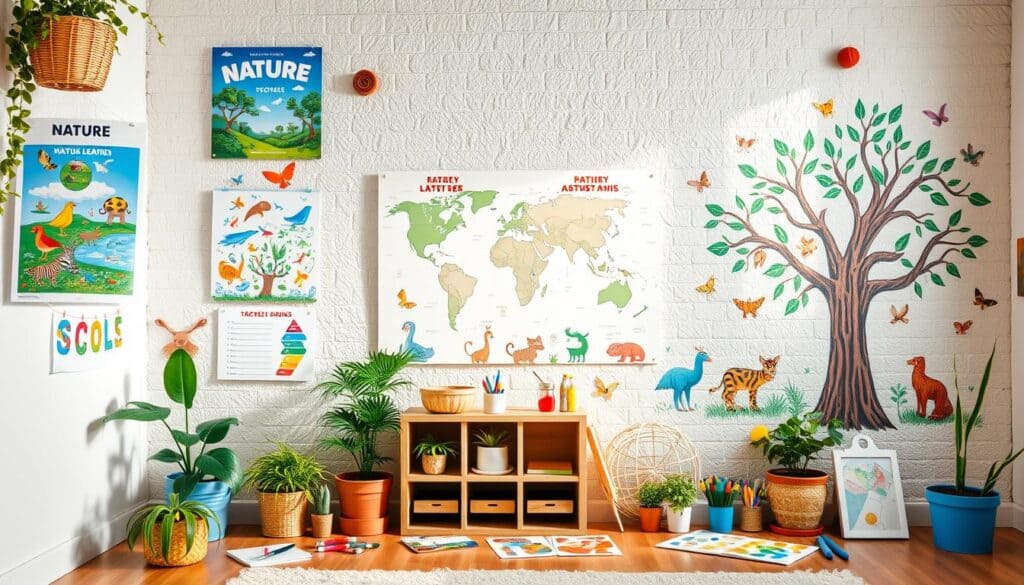
Easy Projects for Parents and Kids
Get your kids involved in making educational wall art. It helps them feel proud of their learning space. Here are some simple projects:
- Alphabet train bulletin board set with 26 sturdy alphabet cards, a locomotive card, and a header
- Inspirational wood signs with motivational quotes
- Animal alphabet wall sticker set featuring an owl numbers tree
- Educational and fun number wall decals package with 4 sheets of stickers
Affordable Materials and Resources
You don’t have to spend a lot on educational wall art supplies. There are many affordable options:
| Material | Cost | Benefits |
|---|---|---|
| Poster board | $1-$2 per sheet | Sturdy, versatile, and easy to cut and decorate |
| Acrylic paint | $1-$3 per color | Vibrant, long-lasting, and easy to clean up |
| Wall decals | $10-$30 per set | Removable, reusable, and easy to apply |
| Printable templates | Free-$5 per download | Customizable, time-saving, and professional-looking |
Use these affordable materials to make stunning educational wall art. It’s engaging for your child and won’t cost a lot. Create unique pieces that show your family’s values and your child’s interests. It also helps them love learning more.
Sourcing Quality Educational Wall Art
Looking for educational wall art for your child’s room? It’s key to pick quality and value. The right art can really help your child learn and grow. Here are some tips to find great educational art and see its value.
Recommended Brands and Sources
For top-notch educational wall art, check out trusted brands. Look for companies that make art that teaches and excites kids. Some top picks include:
- Educational Insights: They have cool posters and charts that teach kids of all ages.
- Lakeshore Learning: They make art that’s fun and teaches important skills like reading and math.
- Melissa & Doug: They’re known for toys, but also have great wall art like alphabet charts.
Evaluating Quality and Educational Value
When picking wall art, think about a few things:
- Age-appropriateness: Make sure the art fits your child’s age and learning level. It should be fun and teach new things.
- Clarity and accuracy: Good educational art should be easy to understand and right. Stay away from art that’s confusing or wrong.
- Durability: Choose art that’s made to last. It should be strong enough for a busy kid’s room.
By picking quality educational wall art and checking its value, you can make a learning space that sparks your child’s curiosity. This will help them grow and learn more.
The Role of Cultural Representation in Wall Art
Choosing the right wall art for your child’s room is important. It should show different cultures and backgrounds. This makes their space welcoming and diverse.
Studies say kids learn a lot from what they see and hear early on. Seeing people like them in media helps kids dream big. By using wall art that shows diversity, you help your child see endless possibilities.
Celebrating Diversity and Inclusion
Using paint swatches in different skin tones is a great idea. It teaches kids about colors and celebrates diversity. For kids of color, seeing themselves in art boosts their self-confidence.
Most arts education focuses on social and emotional learning. By choosing wall art that shows diversity, you help your child grow emotionally and socially.
Choosing Art That Reflects Family Values
Choose wall art that shows your family’s values. Look for pieces that match your traditions and beliefs. This makes your home feel more personal and sparks important talks about your heritage.
Involving students in creating educational displays promotes a sense of ownership and pride in their cultural identities.
Let your child help pick and make wall art for their room. It’s a great way to learn about your family’s history and boost their creativity.
By choosing wall art that shows different cultures, you make a learning space that values everyone. Visual learning can inspire your child’s growth and self-awareness.
Integrating Technology with Traditional Art
In today’s world, technology is everywhere, even in learning. By mixing traditional art with digital tools, you can make learning fun for kids. This mix offers a unique experience that grabs young minds.
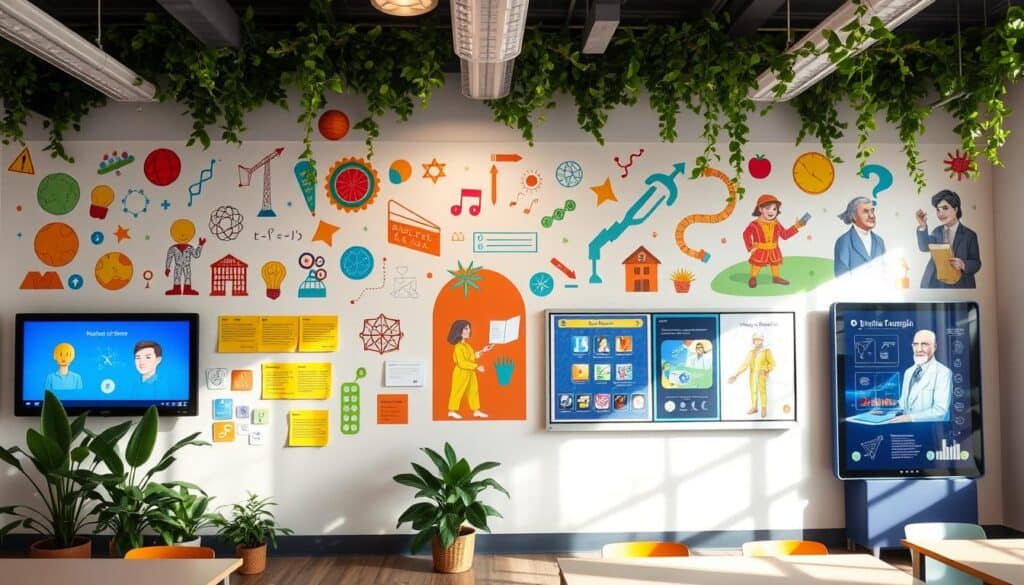
Digital Learning Tools in Decor
Adding digital tools to your home decor makes learning fun for kids. Think about getting a smart display or interactive whiteboard. These can show videos, games, and quizzes, making learning exciting.
Studies show that technology helps in K-12 education. Schools with 1:1 devices see better student engagement. Bringing this to your home can make learning smooth and fun.
Blending Screens with Educational Themes
Choosing the right themes is key when mixing tech and art. Focus on subjects like STEAM to match your child’s interests. Research shows STEAM and literacy together boost learning.
Try a gallery wall with traditional art and digital screens. For example, pair a solar system painting with videos about planets. This creates a rich learning experience that sparks curiosity.
Using technology in learning prepares kids for the future. Educational screens and tech art not only beautify your home. They also offer endless learning chances for your child.
The Impact of Wall Art on Child Development
Educational wall art is key for kids’ growth. It helps with thinking, feelings, and learning through sight. Kids learn important skills from the art around them. These skills help them succeed later on.
Cognitive Benefits of Visual Learning
Art on walls makes kids think more, solve problems, and be creative. Studies show young kids are very smart. They can think in many ways.
Art helps kids learn to talk better too. They use new words and share their thoughts. This is good for their language skills.
- In the first few years, kids’ brains make over a million new connections every second. This shows how important it is to keep their brains active.
- Talking about art helps kids learn new words and how to share their thoughts.
- Art helps kids understand math better. They learn about size, shape, and how to count.
Encouraging Emotional Expression
Wall art lets kids express their feelings in a safe way. It helps them think about their emotions. This makes them more aware of their feelings.
“Art provides children with the opportunity to develop decision-making skills by offering them endless choices and encouraging critical thinking and problem-solving.”
Art helps kids with fine motor skills, hand-eye coordination, and controlling their feelings. These skills help them in many areas of life. They’re good for writing, getting dressed, and solving problems.
Creating a space that values creativity helps kids be themselves. Educational wall art reminds them of their potential. It encourages them to dream, imagine, and grow.
Future Trends in Educational Wall Art
Looking ahead, educational wall art is set to get a big upgrade. We’ll see more focus on being green, using new ideas, and making learning fun. Eco-friendly art is becoming a big deal, with a push for recycled stuff, safe paints, and stuff that breaks down easily. This makes learning spaces better for kids and the planet.
New designs are changing how we learn. Interactive art like magnetic boards and touch screens is making learning hands-on. Kids get to dive into learning in fun ways, boosting their creativity and problem-solving skills.
Eco-Friendly Art Solutions
More people are caring about the planet, and that includes art. Now, we’re seeing wall art made from recycled paper, organic cotton, and bamboo. These choices help reduce waste and teach kids about being green. By picking eco-friendly art, you’re helping raise a generation that cares about the environment.
Innovative Designs for Learning Spaces
The future of educational wall art is all about cool designs that make learning exciting. We’re seeing wall art that uses augmented reality and virtual reality. Imagine a world map that comes alive or a periodic table that teaches you about elements in a new way. These designs turn learning spaces into places that spark curiosity and make kids want to explore.
